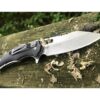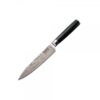A sharp knife is a safe knife! Sounds bizarre, right? Let us explain. Dull blades on any knife require the user to apply additional pressure. With an edge that is dull, there is an increased chance of slippage that may result in injury. Most injuries are related to knives that have not properly been maintained. Follow the steps below to obtain optimal precision for slicing your way through anything.
Grinding and Honing Techniques
Sharpening the blade of the knife can be divided into two different steps. Grinding is the removal of metal that helps refine the angle of the blade. And honing is sharpening via abrasion to create a finer edge. Honing is sometimes referred to as steeling, a method using a honing steel rod that straightens out the edge of the blade.
Honing steel is best used for maintaining a knife. To properly hone a knife with a sharpening steel, or sharpening rod you will hold the rod with your fingers tucked behind the base of the steel. Holding the rod firmly in one hand and the knife in the other, position the blade 20 degrees. Take long strokes with the heel of the knife at the base of the steel and glide towards the top of the steel with the tip of the knife in one motion.
Image Source: http://www.wusthof.com/care-and-sharpening/using-a-steel
The steel should remain firmly in place as the knife moves diagonally across. Repeat these steps, then alternate with the blade on the underside of the steel rod to get the opposing side of the blade. Always remember to slide the blade away from yourself to minimize risk of injury. The act of honing should be done right before or right after using the knife and can become part of your daily routine to increase the longevity of your blade.
For a knife that needs more attention than the straightening process of honing, grinding or sharpening with a sharpening stone or knife sharpener is necessary. This process is referred to as grinding. Grinding is when an abrasive material removes the worn away pieces of the blade and leaves new material at the surface.
Image Source: https://unsplash.com/photos/BtHjHxh-D7I
A whetstone or sharpening stone is often used to implement the grinding process. The stone has two abrasive sides, one course, and one fine. The stone is soaked in water for lubrication. The knife is then placed at a 20-degree angle where the heel of the knife is pressed down on the stone and with a gliding, even pressure the blade is ground from base to tip. After multiple strokes on the rough side, flip the stone to the finer abrasion and repeat the process. A trick when using whetstones is to keep them wet. This allows the waste material to be discarded without clogging the stone with debris.
Modern Fix for a Dull Blade
Electrical and manual knife sharpeners are the modern fix for a dull blade. With an electric sharpener, the abrasives are on motorized wheels that spin against the blade as you insert from the base of the knife and pull backward in a slow and straight motion towards the tip. Manual knife sharpener inners are V-shaped chambers where the user pulls the knife from the base to the tip repeatedly. The shape of the chamber allows for the abrasives to push against both sides of the knife.
Image Source: https://www.touchofmodern.com/sales/anysharp-626c6c24-7744-4ab3-9549-9341a2718785/anysharp-pro-metal
With varied techniques from a honing steel to whetstones, there are at-home knife care options for knife connoisseurs of all skill levels. Professional sharpening services are available if you don’t feel comfortable doing it yourself. This allows you to drop off knives that are severely dull to have them professionally sharpened. The combination of grinding and honing techniques will reap the best result with continued daily maintenance.
For more information regarding the maintenance of your BucknBear knife, please reach out to us at support@bucknbearknives.com. Stay safe & stay sharp!


